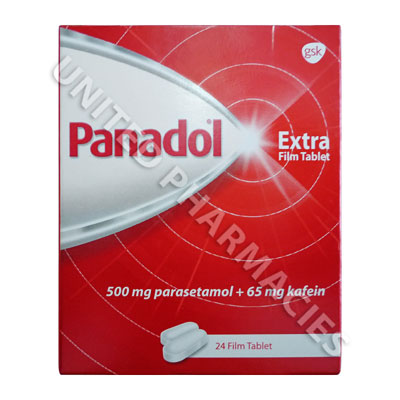Customers also like
Cafergot (Ergotamine/Caffeine) - 1mg/100mg (100 Tablets)
our best price : $57.75
Dicoliv-MR (Diclofenac Potassium/Paracetamol/Chlorzoxazone) - 50mg/325mg/250mg (10 Tablet)
our best price : $4.10
Paramax (Paracetamol/Metoclopramide) - 500mg/5mg (60 Tablets)
our best price : $19.85
Description
Panadol (Paracetamol) is used to manage such symptoms as:
- Pain syndrome: headache, migraine, toothache, sore throat, back pain, muscle pain, painful menstruation;
- Fever syndrome (as an anti-febrile medication): high body temperature due to influenza and cold-related diseases.
The medication is aimed at reducing pain at the time of administration and does not affect the progression of the disease.
In adults (including the elderly), the standard dosage is 500mg to 1g (1-2 tablets), taken up to 4 times per day, if necessary. The intervals between the doses have to be at least 4 hours. A single dose (2 tablets) can be taken maximum 4 times (8 tablets) within 24 hours.
In children at the age of 6-9 years, the standard dosage is 1/2 of a tablet, taken 3-4 times per day, if necessary. The intervals between the doses have to be at least 4 hours. The maximum single dose for children at the age of 6-9 years is 1/2 of a tablet (250mg), while the maximum daily dose is 2 tablets (1g).
In children at the age of 9-12 years, the standard dosage is 1 tablet, taken up to 4 times per day, if necessary. The intervals between the doses have to be at least 4 hours. A single dose (1 tablet) can be taken maximum 4 times (4 tablets) within 24 hours.
It is not recommended to use Panadol (Paracetamol) - 500mg (24 Tablets) for over 5 days as an analgesic and for over 3 days as an antipyretic without instruction and supervision of the physician. The increase in the daily dose of the medication or in the duration of treatment can only possible under your physician`s supervision.
Usually, Panadol (Paracetamol) is well tolerated when taken in the recommended doses.
Allergic reactions: occasionally - skin rash, itching, angioedema.
Blood system: rarely - anemia, thrombocytopaenia, methemoglobinemia.
Urinary system: long-term administration of high doses - renal colic, general bacteriuria, interstitial nephritis, renal papillary necrosis.
Panadol (Paracetamol) is counter indicated in the following cases:
- Pediatric use in patients at the age below 6 years;
- Increased sensitivity to the components of the medication.
Caution is required when Panadol (Paracetamol) is administered to elderly patient and to patients with kidney and liver failure, benign hyperbilirubinemias (including Gilbert`s syndrome), viral hepatitis, glucose-6-phosphate dehydrogenase deficiency, alcohol-induced liver damage, and alcohol addiction.
During pregnancy and breast-feeding Panadol (Paracetamol) has to be administered with caution and under the supervision of a physician.
When Panadol (Paracetamol) has to be administered on a long-term basis and in high doses, it is required to monitor the blood count.
Panadol (Paracetamol) should be used with caution and under the supervision of a physician in patients with liver and kidney diseases and patients taking antiemetic medications (such as Metoclopramide, Domperidone) or cholesterol lowering medications (such as Colestyraminum) simultaneously.
In case there`s a daily need for analgesics along with anticoagulants, Panadol (Paracetamol) can be taken only occasionally.
When testing blood uric acid and glucose levels, it is necessary to inform your physician that you`re taking Panadol (Paracetamol).
To avoid toxic damage to the liver, Panadol (Paracetamol) should not be combined with alcohol and should not be taken by persons prone to chronic alcohol.










